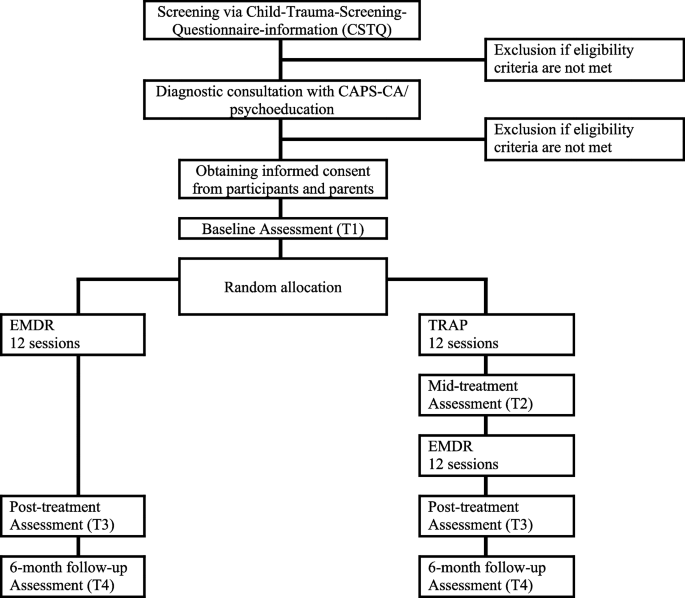Treatment of multiple traumatized adolescents by enhancing regulation skills and reducing trauma related symptoms: rationale, study design, and methods of randomized controlled trial (the Mars-study) – BMC Psychiatry
Treatment of multiple traumatized adolescents by enhancing ... BMC Psychiatry


Study design
This study entails a single-blind, randomized controlled trial with two arms: a phase-based treatment condition (TRAP followed by EMDR) and a trauma-focused treatment condition (EMDR only). In the TRAP-EMDR condition, participants receive 12 sessions of skills training (TRAP; the Dutch adolescents version of the STAIRS protocol), followed by 12 sessions of EMDR therapy. In the other condition, the participants receive 12 EMDR sessions. The two groups will be compared for several outcome variables before treatment, immediately after 12 sessions (post-treatment), and six months post-treatment (follow-up) (see Fig. 1). This study will be coordinated by the Karakter Academic Center for Child and Adolescent Psychiatry in the Netherlands. The study started in 2018, paused for seven months in 2020 due to COVID-19, and continued in September 2020. This study is ongoing and is expected to be completed by 2024.
Participants
Participants are individuals between 12 and 18 years of age, meeting the criteria for PTSD (according to the Diagnostic and Statistical Manual of Mental Disorders, fifth edition), and victims of repeated sexual and/or physical abuse and/or domestic violence in childhood. Participants are recruited from different departments of Karakter, a large mental health organization for children and adolescents in the Netherlands. This applies the following inclusion criteria:
- Meeting the criteria for PTSD, assessed with the Clinical-Administered PTSD Scale for Children and Adolescents (CAPS-CA)
- Reporting a history of (repeated) physical and/or sexual abuse and/or domestic violence by a caretaker, family member, or person in authority
- The availability of a non-offending adult caregiver for the treatment, as the presence of a caregiver is part of the treatment design
- Motivation and ability of the participant and the caregiver to attend weekly treatment sessions
- Safe living circumstances to minimize the risk of retraumatization during the study
- Participants and caregivers have sufficient command of the Dutch language to participate in the treatment
Exclusion criteria are:
- Acute suicidal behavior or suicidal ideations requiring immediate hospitalization
- Severe head trauma indicated by a score < 9 on the Glasgow Coma Scale as known from the participant’s medical history, to avoid brain dysfunction or retrograde amnesia of the traumatic event due to head injury
- Concurrent psychotherapy during the study
- Current severe mental disorder in the participant’s main caregiver (as evaluated by the responsible clinician), such as psychosis, severe episode of depression, or severe substance abuse, to assure the ability of the caregiver to participate in the treatment
- A sibling of the participant already participating in the study (to avoid the transference of treatment effects if siblings are randomized in different conditions)
- Intellectual disabilities (IQ < 70)
Randomization
Once the informed consent form is signed and the baseline questionnaires (T0 and T1) are completed, the randomization procedure begins. Participants are randomly assigned to either a control or an experimental group with a 1:1 allocation according to a computer-generated randomization schedule stratified by sex (male or female) and psychiatric diagnoses and using permuted blocks of random sizes. The block sizes will not be disclosed to ensure concealment. Participants will be randomized using randomization.com, an online randomization tool. Allocation concealment will be ensured because the person who performs randomization has no other role in the study. This person will prepare the randomization lists and seal the envelopes. The randomization code will not be released until the participant is recruited into the trial, which occurs after all baseline measurements have been completed.
To ensure allocation concealment, the steps involved in randomization, outcome measurements, and treatment are separated. Participants who meet the inclusion criteria and provide consent for participation will be randomized. Research assistants responsible for recruitment and outcome measurement will request randomization.
SDGs, Targets, and Indicators
| SDGs | Targets | Indicators |
|---|---|---|
| SDG 3: Good Health and Well-being | Target 3.4: By 2030, reduce by one-third premature mortality from non-communicable diseases through prevention and treatment and promote mental health and well-being | Indicator not mentioned in the article |
| SDG 4: Quality Education | Target 4.7: By 2030, ensure that all learners acquire the knowledge and skills needed to promote sustainable development, including among others through education for sustainable development and sustainable lifestyles, human rights, gender equality, promotion of a culture of peace and non-violence, global citizenship, and appreciation of cultural diversity and of culture’s contribution to sustainable development | Indicator not mentioned in the article |
| SDG 5: Gender Equality | Target 5.2: Eliminate all forms of violence against all women and girls in the public and private spheres, including trafficking and sexual and other types of exploitation | Indicator not mentioned in the article |
| SDG 10: Reduced Inequalities | Target 10.2: By 2030, empower and promote the social, economic, and political inclusion of all, irrespective of age, sex, disability, race, ethnicity, origin, religion or economic or other status | Indicator not mentioned in the article |
| SDG 16: Peace, Justice, and Strong Institutions | Target 16.2: End abuse, exploitation, trafficking and all forms of violence against and torture of children | Indicator not mentioned in the article |
Analysis
1. Which SDGs are addressed or connected to the issues highlighted in the article?
The issues highlighted in the article are related to mental health and well-being, specifically the treatment of post-traumatic stress disorder (PTSD) in adolescents who have experienced repeated sexual and/or physical abuse and/or domestic violence. Therefore, the SDGs connected to these issues are:
– SDG 3: Good Health and Well-being
– SDG 4: Quality Education
– SDG 5: Gender Equality
– SDG 10: Reduced Inequalities
– SDG 16: Peace, Justice, and Strong Institutions
2. What specific targets under those SDGs can be identified based on the article’s content?
Based on the article’s content, the specific targets under the identified SDGs are:
– Target 3.4: By 2030, reduce by one-third premature mortality from non-communicable diseases through prevention and treatment and promote mental health and well-being.
– Target 4.7: By 2030, ensure that all learners acquire the knowledge and skills needed to promote sustainable development, including among others through education for sustainable development and sustainable lifestyles, human rights, gender equality, promotion of a culture of peace and non-violence, global citizenship, and appreciation of cultural diversity and of culture’s contribution to sustainable development.
– Target 5.2: Eliminate all forms of violence against all women and girls in the public and private spheres, including trafficking and sexual and other types of exploitation.
– Target 10.2: By 2030, empower and promote the social, economic, and political inclusion of all, irrespective of age, sex, disability, race, ethnicity, origin, religion or economic or other status.
– Target 16.2: End abuse, exploitation, trafficking and all forms of violence against and torture of children.
3. Are there any indicators mentioned or implied in the article that can be used to measure progress towards the identified targets?
No indicators are mentioned or implied in the article that can be used to measure progress towards the identified targets.
Table: SDGs, Targets, and Indicators
| SDGs | Targets | Indicators |
|---|---|---|
| SDG 3: Good Health and Well-being | Target 3.4: By 2030, reduce by one-third premature mortality from non-communicable diseases through prevention and treatment and promote mental health and well-being | Indicator not mentioned in the article |
| SDG 4: Quality Education | Target 4.7: By 2030, ensure that all learners acquire the knowledge and skills needed to promote sustainable development, including among others through education for sustainable development and sustainable lifestyles, human rights, gender equality, promotion of a culture of peace and non-violence, global citizenship, and appreciation of cultural diversity and of culture’s contribution to sustainable development | Indicator not mentioned in the article |
| SDG 5: Gender Equality | Target 5.2: Eliminate all forms of violence against all women and girls in the public and private spheres, including trafficking and sexual and other types of exploitation | Indicator not mentioned in the article |
| SDG 10: Reduced Inequalities | Target 10.2: By 2030, empower and promote the social, economic, and political inclusion of all, irrespective of age, sex, disability, race, ethnicity, origin, religion or economic or other status | Indicator not mentioned in the article |
| SDG 16: Peace, Justice, and Strong Institutions | Target 16.2: End abuse, exploitation, trafficking and all forms of violence against and torture of children | Indicator not mentioned in the article |
Behold! This splendid article springs forth from the wellspring of knowledge, shaped by a wondrous proprietary AI technology that delved into a vast ocean of data, illuminating the path towards the Sustainable Development Goals. Remember that all rights are reserved by SDG Investors LLC, empowering us to champion progress together.
Source: bmcpsychiatry.biomedcentral.com

Join us, as fellow seekers of change, on a transformative journey at https://sdgtalks.ai/welcome, where you can become a member and actively contribute to shaping a brighter future.








